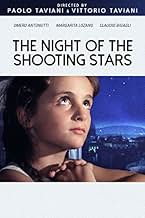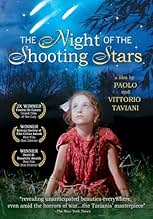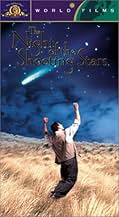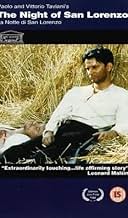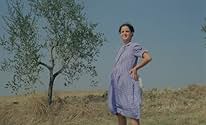IMDb-BEWERTUNG
7,2/10
4906
IHRE BEWERTUNG
Füge eine Handlung in deiner Sprache hinzuIn 1944, the residents of a small Italian town under Axis control flee their homes to seek out the liberating Allied forces.In 1944, the residents of a small Italian town under Axis control flee their homes to seek out the liberating Allied forces.In 1944, the residents of a small Italian town under Axis control flee their homes to seek out the liberating Allied forces.
- Auszeichnungen
- 19 Gewinne & 13 Nominierungen insgesamt
Sergi Dagliana
- Olinto
- (as Sergio Dagliana)
Empfohlene Bewertungen
If you want to know how Italians lived and felt in the Second World War, how they managed the terror, you have to watch this movie. Have you imagined your neighbors collaborating with the Nazi-Fascist army? Have you imagined can't trusting in your relatives? Have you imagined yourself being chased and having to run away on foot for kilometers? Well, most of us have never faced this situation (some of us did) and this movie is one portrait of what Nazism/Fascism was to Europe.
In the World War II, part of the citizens of the Italian Tuscan town of San Martino decide to leave their homes in the night of San Lorenzo, escaping from the Germans, and searching for the Americans. In the way, they fight against the Fascists, and most of them survive. The story is told by the character Cecilia, an unpleasant six years old girl at that time. Yesterday I watched this famous movie for the first time. I do not know whether was the high expectation I had, but I find it too personal and disappointing. The amateurish cast has not passed emotion to me. The story is very simple and too personal and has not engaged me. I would not like to be unfair, but I have not seen anything special in this small budget realistic movie. I usually do not read any comment of a film before writing mine, but I read the review of Howard Schumann (Vancouver, B.C) and I found it excellent. My vote is six.
Title (Brazil): `A Noite de São Lourenço' (`The Night of San Lorenzo')
Title (Brazil): `A Noite de São Lourenço' (`The Night of San Lorenzo')
The Night of the Shooting Stars is the semi-autobiographical recollection by the Taviani Brothers of the night when a group of peasants in a small Tuscan village left their homes that had been mined by the Fascists to look for liberating American soldiers rumored to be on the outskirts. Set on the night of the Feast of St. Lawrence in the closing days of World War II, and enhanced by a haunting score by Nicola Piovani, the film is a tragi-comic glimpse of what the war was like to an impressionable child filtered through years of memory. It is essentially a series of vignettes combining fact, memory, and poetic imagination told in flashback by a mother recalling her days as a 6-year old girl named Cecilia caught in the middle of war.
The film focuses on the nature of a conflict in which life long friends from the same village are often engaged in the struggle on different sides. Especially vivid is a scene involving a battle in a wheat field between the villagers and home grown Fascists, and a heart wrenching confrontation between the partisans and a father with his 15-year old son. There are many other poignant moments as well: a young couple expecting a child, the village priest who is a collaborator, and an elderly couple rekindling a romance started when they were adolescents.
Night of the Shooting Stars pays homage to the tradition of neo-realism, but also includes surrealistic moments such as when the young girl sees the partisans as Greek warriors, while the Fascist who threatens her life falls dead, pierced by multiple spears. Though Night of the Shooting Stars suffers from overacting, its unique approach allows us to see war as a very personal experience with all of its sadness and cruelty. It was also gratifying to see Americans being held in high esteem, an experience we haven't enjoyed much of recently.
The film focuses on the nature of a conflict in which life long friends from the same village are often engaged in the struggle on different sides. Especially vivid is a scene involving a battle in a wheat field between the villagers and home grown Fascists, and a heart wrenching confrontation between the partisans and a father with his 15-year old son. There are many other poignant moments as well: a young couple expecting a child, the village priest who is a collaborator, and an elderly couple rekindling a romance started when they were adolescents.
Night of the Shooting Stars pays homage to the tradition of neo-realism, but also includes surrealistic moments such as when the young girl sees the partisans as Greek warriors, while the Fascist who threatens her life falls dead, pierced by multiple spears. Though Night of the Shooting Stars suffers from overacting, its unique approach allows us to see war as a very personal experience with all of its sadness and cruelty. It was also gratifying to see Americans being held in high esteem, an experience we haven't enjoyed much of recently.
10jotix100
The night of August 10th, when the feast of St. Lawrence is observed, is the time of the year when meteor showers can be observed in the sky. It has been a tradition in the western culture that wishing for a favor when watching the falling stars in the sky is a way to ask for love, riches and luck. The sky watchers can expect a spectacle like no other because of the way those distant lights are seen falling, fast and furious.
The brothers Taviani, Paolo and Vittorio, have always come out with interesting films that involve simple people, usually connected to the land. In "La Notte di San Lorenzo", the Tavianis take the viewer to witness a group of people from Tuscany during the last days of WWII. The story is told by a 6 years old girl who was too young to realize the horrors around her in those final days of the conflict.
In spite of the approaching American liberating army, there are still the horrible local Fascists, who knowing they were fighting a losing battle, terrorized their neighbors into submission. These misguided people, having mined most of the houses in the town, are feared by the local population. Some flee into the countryside, but some remain in the town, convinced that being in the big church will protect them against evil.
Things go from bad to worse. We see different vignettes involving some of the people, as they cope with the situation. There is Galvano, who has loved Concetta in silence and is finally, as in a miracle, gets his wish granted in the way that she acknowledges that she has always love him, even after both have been married to different people. There's the young pregnant young bride, who is expecting and who gets married at the beginning of the film, only to be separated from her husband in an ironic twist.
The Tavianis painted a huge canvas in which they situated the action. Tuscany in the summer is a lovely place to be, but one can't even comprehend that it was also the scene for the tragedy lived in Italy in those tragic years. The music by Nicola Piovani is effective in the background. Franco DiGiacomo's photography does wonders to make the film a great experience. The large cast does an excellent job for the Tavianis, who are ultimately, the ones to thank for their courage in presenting us this lyrical movie of beauty and death.
The brothers Taviani, Paolo and Vittorio, have always come out with interesting films that involve simple people, usually connected to the land. In "La Notte di San Lorenzo", the Tavianis take the viewer to witness a group of people from Tuscany during the last days of WWII. The story is told by a 6 years old girl who was too young to realize the horrors around her in those final days of the conflict.
In spite of the approaching American liberating army, there are still the horrible local Fascists, who knowing they were fighting a losing battle, terrorized their neighbors into submission. These misguided people, having mined most of the houses in the town, are feared by the local population. Some flee into the countryside, but some remain in the town, convinced that being in the big church will protect them against evil.
Things go from bad to worse. We see different vignettes involving some of the people, as they cope with the situation. There is Galvano, who has loved Concetta in silence and is finally, as in a miracle, gets his wish granted in the way that she acknowledges that she has always love him, even after both have been married to different people. There's the young pregnant young bride, who is expecting and who gets married at the beginning of the film, only to be separated from her husband in an ironic twist.
The Tavianis painted a huge canvas in which they situated the action. Tuscany in the summer is a lovely place to be, but one can't even comprehend that it was also the scene for the tragedy lived in Italy in those tragic years. The music by Nicola Piovani is effective in the background. Franco DiGiacomo's photography does wonders to make the film a great experience. The large cast does an excellent job for the Tavianis, who are ultimately, the ones to thank for their courage in presenting us this lyrical movie of beauty and death.
There are many ways to portrait war, and the Tavianis choose a very circuitous one: By showing it through the eyes of a group of refugees - who, naturally, try to stay away from the fights as much as possible. Many of those refugees are real characters, with little stories of their own, so it's less a film about the actual WW2, but rather about how people react to war as a whole, how it can bring out the best (or worst) in a man and how it upsets everything you took for granted.
One of the nicest things about "La notte di San Lorenzo" is how there's always something lovely or funny to be found - comic or beautiful situations under the direst of circumstances, even if the laughter dies in your throat a few seconds later when violence cruelly rises again. This film celebrates life and humanity itself!
One of the nicest things about "La notte di San Lorenzo" is how there's always something lovely or funny to be found - comic or beautiful situations under the direst of circumstances, even if the laughter dies in your throat a few seconds later when violence cruelly rises again. This film celebrates life and humanity itself!
Wusstest du schon
- WissenswertesThe church scene, where Germans bomb the church full of people, was based on real life events that took place in San Miniato (the birthplace of Paolo Taviani and Vittorio Taviani). However, more than two decades after this movie was made, the case was reopened and it was discovered, that the fatal bomb actually belonged to the American army, and hit the church accidentally.
- PatzerA man, likely Dilvo, raises watermelon to his mouth with both hands, but in the next shot is eating it only with the right hand.
- VerbindungenFeatured in Marcello Mastroianni: mi ricordo, sì, io mi ricordo (1997)
Top-Auswahl
Melde dich zum Bewerten an und greife auf die Watchlist für personalisierte Empfehlungen zu.
- How long is The Night of the Shooting Stars?Powered by Alexa
Details
- Erscheinungsdatum
- Herkunftsland
- Sprachen
- Auch bekannt als
- The Night of the Shooting Stars
- Drehorte
- Empoli, Tuscany, Italien(church bombing scene on Piazza Farinata degli Uberti)
- Produktionsfirmen
- Weitere beteiligte Unternehmen bei IMDbPro anzeigen
Box Office
- Bruttoertrag in den USA und Kanada
- 2.257.307 $
- Eröffnungswochenende in den USA und in Kanada
- 4.414 $
- 16. Aug. 2015
- Weltweiter Bruttoertrag
- 2.257.307 $
- Laufzeit
- 1 Std. 47 Min.(107 min)
- Sound-Mix
- Seitenverhältnis
- 1.66 : 1
Zu dieser Seite beitragen
Bearbeitung vorschlagen oder fehlenden Inhalt hinzufügen




